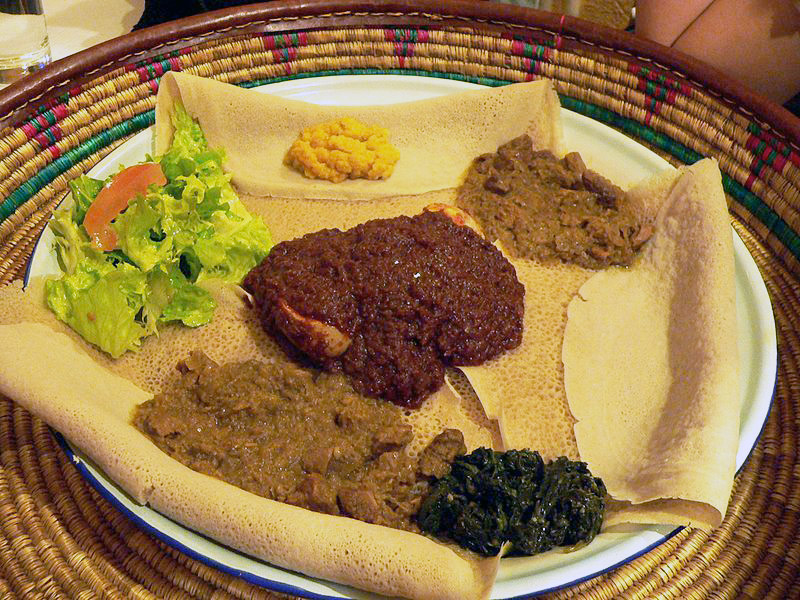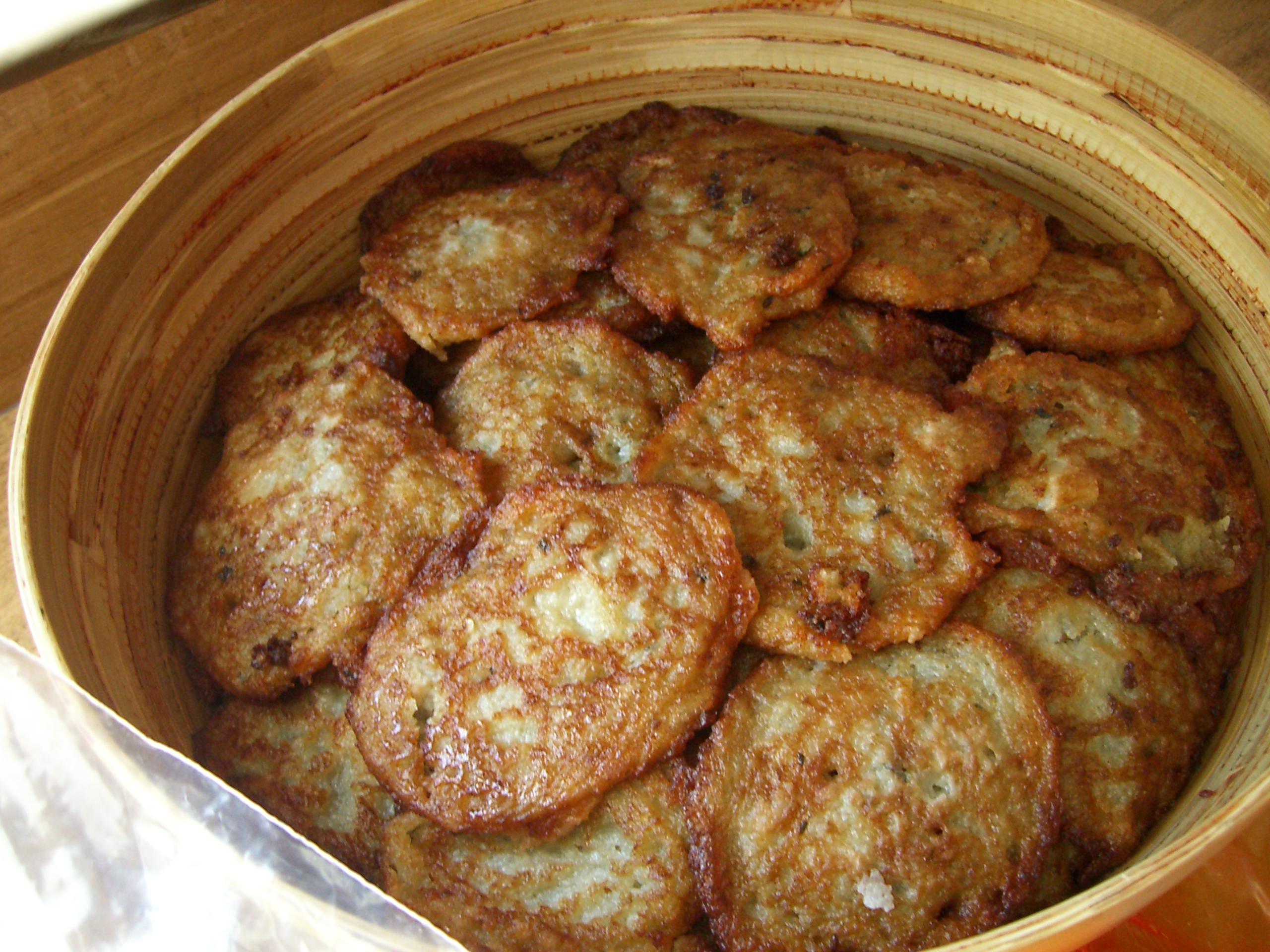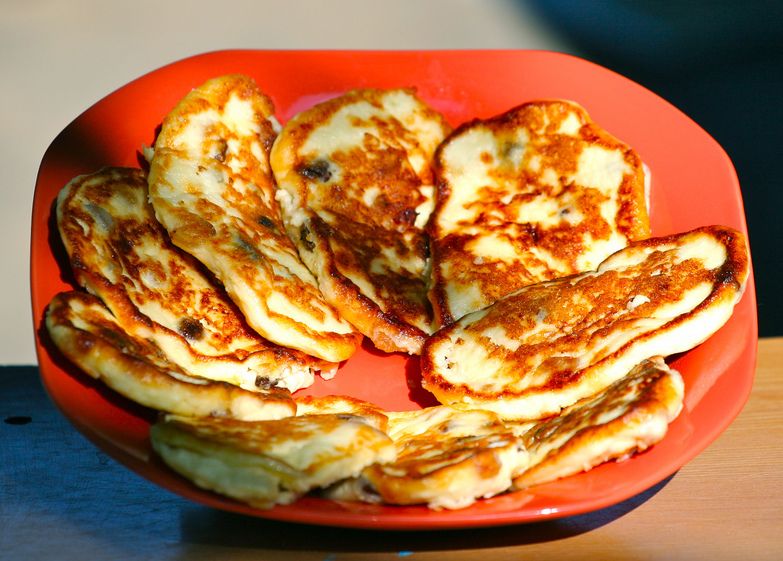|
Oladyi
Oladyi ( pl., diminutive: оладушки, ''oladushki'', sg. оладья, ''oladya'' , , ''oladky'') are small thick pancakes or fritters common in Russian and Ukrainian cuisines. The batter for oladyi is made from wheat or (nowadays more rarely) buckwheat flour, eggs, milk, salt, and sugar with yeast or baking soda. The batter may also contain kefir, soured milk or yoghurt. Oladyi may also include various additions, such as apple or raisins. Oladyi are usually served with smetana ( sour cream), as well as with sweet toppings such as jam, powidl, honey etc. Savoury versions may be served with caviar, similarly to blini. Generally, the term ''oladyi'' in Eastern Slavic cuisines may also denote fritters made with other ingredients, e.g. potato pancakes (картофельные оладьи), carrot fritters (морковные оладьи), bean pancakes (оладьи из бобовых), rice pancakes (рисовые оладьи), summer squash fritters (ка� ... [...More Info...] [...Related Items...] OR: [Wikipedia] [Google] [Baidu] |
Pancake
A pancake, also known as a hotcake, griddlecake, or flapjack, is a flat type of batter bread like cake, often thin and round, prepared from a starch-based Batter (cooking), batter that may contain eggs, milk, and butter, and then cooked on a hot surface such as a griddle or frying pan. Archaeological evidence suggests that pancakes were probably eaten in prehistoric societies. The pancake's shape and structure varies worldwide. In England, pancakes are often Leavening agent, unleavened and resemble a crêpe. In Scotland and North America, a leavening agent is used (typically baking powder) creating a thick fluffy pancake. A ''crêpe'' is a thin pancake of Brittany, Breton origin cooked on one or both sides in a special pan or crepe maker to achieve a lacelike network of fine bubbles. A well-known variation originating from southeast Europe is palatschinke, a thin moist pancake fried on both sides and filled with jam, cream cheese, chocolate, or ground walnuts, but many other f ... [...More Info...] [...Related Items...] OR: [Wikipedia] [Google] [Baidu] |
Potato Pancake
Potato pancakes are shallow-fried pancakes consisting of grated or ground potato, matzo meal or flour and a binding ingredient such as egg or apple sauce, often flavored with grated garlic or onion and seasonings. They may be topped with a variety of condiments, ranging from the savory (such as sour cream or cottage cheese), to the sweet (such as apple sauce or sugar), or they may be served plain. The dish is sometimes made from mashed potatoes to make pancake-shaped croquettes. Some variations are made with sweet potatoes. In different cultures Potato pancakes are associated with various European cuisines, including Irish (as boxty), German and Austrian (as '' Kartoffelpuffer'', ', ', ' and '), Dutch (as ', ', '), Belarusian (as '), Bulgarian (as '), Czech (as '','' ' or ''vošouch''), Hungarian (as ', and other names), Jewish (as ', , ', plural '), Latvian (as '), Lithuanian (as '), Luxembourg ('), Polish (as '), Romanian (as ''tocini'' or ''tocinei''), Russi ... [...More Info...] [...Related Items...] OR: [Wikipedia] [Google] [Baidu] |
Syrniki
Syrniki (; ; ) are fried Eastern Slavic quark (curd cheese) pancakes. They are a part of Belarusian, Russian, Ukrainian, Latvian (''biezpiena plācenīši'') and Lithuanian cuisine (''varškėčiai''). In Russia, they are also known as tvorozhniki (творо́жники). Etymology The name ''syrniki'' is derived from the Slavic word ''syr'' (сир), meaning a soft curd cheese. The Ukrainian language retains the old Slavic sense of the word, as in ''domashnii syr'' (домашній сир, literal translation 'domestic cheese'), whereas in Russian another old Slavic word for curd cheese, ''tvorog'' (творог), is used. Preparation Syrnyky or tvorozhniki are made from creamy tvorog, mixed with flour, eggs and sugar, sometimes adding vanilla extract. Pot cheese or farmer's cheese or quark is suggested as a substitute for the '' tvorog''. The soft mixture is shaped into cakes, which are pan- or shallow-fried in vegetable oil or in hot butter. The consiste ... [...More Info...] [...Related Items...] OR: [Wikipedia] [Google] [Baidu] |
Potato Pancake
Potato pancakes are shallow-fried pancakes consisting of grated or ground potato, matzo meal or flour and a binding ingredient such as egg or apple sauce, often flavored with grated garlic or onion and seasonings. They may be topped with a variety of condiments, ranging from the savory (such as sour cream or cottage cheese), to the sweet (such as apple sauce or sugar), or they may be served plain. The dish is sometimes made from mashed potatoes to make pancake-shaped croquettes. Some variations are made with sweet potatoes. In different cultures Potato pancakes are associated with various European cuisines, including Irish (as boxty), German and Austrian (as '' Kartoffelpuffer'', ', ', ' and '), Dutch (as ', ', '), Belarusian (as '), Bulgarian (as '), Czech (as '','' ' or ''vošouch''), Hungarian (as ', and other names), Jewish (as ', , ', plural '), Latvian (as '), Lithuanian (as '), Luxembourg ('), Polish (as '), Romanian (as ''tocini'' or ''tocinei''), Russi ... [...More Info...] [...Related Items...] OR: [Wikipedia] [Google] [Baidu] |
Blini
Blini (plural ''blinis'' or ''blini'', rarely ''bliny''; pl., Ukrainian: млинці pl., ''mlyntsi''), singular: blin, are an Eastern European crêpe made from various kinds of flour of buckwheat, wheat, etc. They may be served with smetana, cottage cheese, caviar and other garnishes, or simply smeared with butter. They are a traditional Slavic dish. In the West, blini traditionally refers to small savory pancakes made with leavened batter. In modern Russian, the term most often refers to pan-sized leavened thin pancakes, although smaller leavened pancakes are also called blini. Smaller and thicker pancakes (with several of them baked on one larger pan) are called '' oladyi''. Blintzes, called ''blinchiki'' (little blinis) in Russian are an offshoot of blini or crêpes. They are basically rolls based on thin pancakes usually made of wheat flour, folded to form a casing for various kinds of filling, typically cheese, fruit, or (in Russian cuisine) pre-fried mince ... [...More Info...] [...Related Items...] OR: [Wikipedia] [Google] [Baidu] |
Honey
Honey is a sweet and viscous substance made by several species of bees, the best-known of which are honey bees. Honey is made and stored to nourish bee colonies. Bees produce honey by gathering and then refining the sugary secretions of plants (primarily floral nectar) or the secretions of other insects, like the honeydew of aphids. This refinement takes place both within individual bees, through regurgitation and enzymatic activity, and during storage in the hive, through water evaporation that concentrates the honey's sugars until it is thick and viscous. Honey bees stockpile honey in the hive. Within the hive is a structure made from wax called honeycomb. The honeycomb is made up of hundreds or thousands of hexagonal cells, into which the bees regurgitate honey for storage. Other honey-producing species of bee store the substance in different structures, such as the pots made of wax and resin used by the stingless bee. Honey for human consumption is collected ... [...More Info...] [...Related Items...] OR: [Wikipedia] [Google] [Baidu] |
A Gift To Young Housewives
''A Gift to Young Housewives'' () is a Russian literature, Russian cookbook written and compiled by and usually referred to as "Molokhovets" rather than its long title. It was the most successful book of its kind in the 19th and early 20th-century in Russia. Molokhovets revised the book continually between 1861 and 1917, a period of time falling between the Emancipation reform of 1861, emancipation of the serfs and the Russian Revolution, Communist Revolution. The book was well known in Russian households during publication and for decades afterwards. It was republished in 2003. Classic Russian cooking The original series went through more than 20 editions and sold more than 295,000 copies. The book gave instructions for elaborate dishes like suckling pig, Madeira cake, and hazel grouse. Other recipes included soups, fritters, tortes, mushrooms, aspics, mousses, and dumplings. There were also instructions on making jam, mustard (condiment), mustard, and vodka. Although the numbe ... [...More Info...] [...Related Items...] OR: [Wikipedia] [Google] [Baidu] |
Jewish Cuisine
Jewish cuisine refers to the worldwide cooking traditions of the Jewish people. During its evolution over the course of many centuries, it has been shaped by Jewish dietary laws (''kashrut''), Jewish festivals and holidays, and traditions centred around Shabbat. Jewish cuisine is influenced by the economics, agriculture, and culinary traditions of the many countries where Jewish communities have settled and varies widely throughout the entire world. The history of Jewish cuisine begins with the cuisine of the ancient Israelites. As the Jewish diaspora grew, different styles of Jewish cooking developed. The distinctive styles in Jewish cuisine vary according to each community across the Ashkenazi, Sephardi, and Mizrahi diaspora groupings; there are also notable dishes within the culinary traditions of the standalone significant Jewish diaspora communities from Greece, Iran, and Yemen. Since the establishment of the State of Israel in 1948, and particularly since the late 19 ... [...More Info...] [...Related Items...] OR: [Wikipedia] [Google] [Baidu] |
Ancient Greek
Ancient Greek (, ; ) includes the forms of the Greek language used in ancient Greece and the classical antiquity, ancient world from around 1500 BC to 300 BC. It is often roughly divided into the following periods: Mycenaean Greek (), Greek Dark Ages, Dark Ages (), the Archaic Greece, Archaic or Homeric Greek, Homeric period (), and the Classical Greece, Classical period (). Ancient Greek was the language of Homer and of fifth-century Athens, fifth-century Athenian historians, playwrights, and Ancient Greek philosophy, philosophers. It has contributed many words to English vocabulary and has been a standard subject of study in educational institutions of the Western world since the Renaissance. This article primarily contains information about the Homeric Greek, Epic and Classical periods of the language, which are the best-attested periods and considered most typical of Ancient Greek. From the Hellenistic period (), Ancient Greek was followed by Koine Greek, which is regar ... [...More Info...] [...Related Items...] OR: [Wikipedia] [Google] [Baidu] |
Domostroy
''Domostroy'' (, , ) is a 16th-century Russian set of household rules, instructions and advice pertaining to various religious, social, domestic, and family matters of Russian society. Core ''Domostroy'' values tended to reinforce obedience and submission to God, the tsar, and the church. Key obligations were fasting, prayer, icon veneration and the giving of alms. Description Its real author is unknown, but the most widespread version was edited by the archpriest Silvester, an influential advisor to Ivan IV of Russia. The text does include an epistle entitled "64. A Father's Epistle Instructing His Son", which was written by Silvester instructing his son, Anfim, on some of the larger themes found within the ''Domostroy''. An updated edition of the ''Domostroy'' was compiled by Karion Istomin during the late 17th century. To modern researchers, it is a precious account of Russian society and the life of wealthy boyars and merchants. The first part of the ''Domostroy'' is ... [...More Info...] [...Related Items...] OR: [Wikipedia] [Google] [Baidu] |





